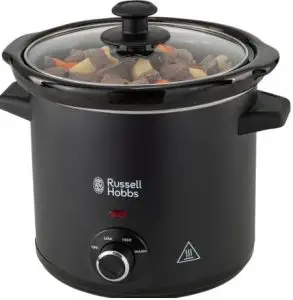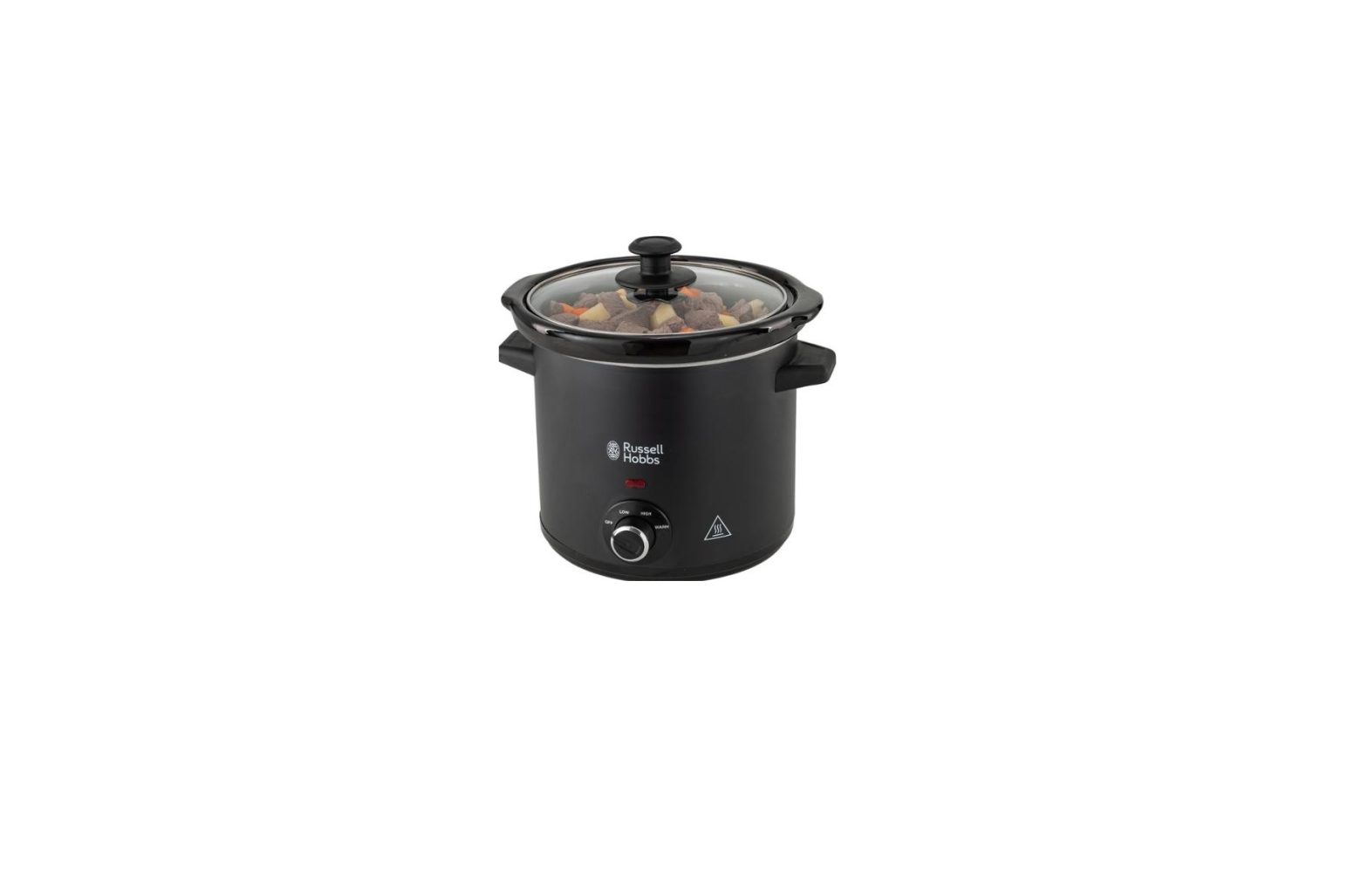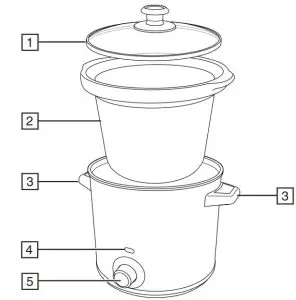Russell Hobbs 24180-56 Slow Cooker User Manual
Product Overview
![]() Read the instructions, keep them safe, pass them on if you pass the appliance on. Remove all packaging before use.
Read the instructions, keep them safe, pass them on if you pass the appliance on. Remove all packaging before use.
IMPORTANT SAFEGUARDS
Follow basic safety precautions, including:
This appliance can be used by children aged from 8 years and above and persons with reduced physical, sensory or mental capabilities or lack of experience and knowledge if they have been supervised/instructed and understand the hazards involved. Children shall not play with the appliance. Cleaning and user maintenance shall not be done by children unless they are older than 8 and supervised. Keep the appliance and cable out of reach of children under 8 years.If the cable is damaged, it must be replaced by the manufacturer, its service agent, or someone similarly qualified, to avoid hazard.
![]() Do not use this appliance near bathtubs, showers, basins or othervessels containing water.
Do not use this appliance near bathtubs, showers, basins or othervessels containing water.![]() The surfaces of the appliance will get hot.
The surfaces of the appliance will get hot.
- Leave a space of at least 50mm all round the appliance.
- Don’t cover the appliance or put anything on top of it.
- Unplug the appliance when not in use, before moving and before cleaning.
- Don’t use the appliance for any purpose other than those described in these instructions.
- Don’t operate the appliance if it’s damaged or malfunctions.
HOUSEHOLD USE ONLY
PARTS
- Lid
- Cooking pot
- Handles
- Light
- Mode switch
- Chalk
IMPORTANT
Before writing on your slow cooker with the supplied chalk you must prepare the surface. If you don’t do this, the chalk may be difficult to erase afterwards. To condition the surface, rub the writing area of your slow cooker with the side of the chalk to give an even coating (Fig A). Wipe off the coating of chalk with a soft cloth and the surface is now conditioned and ready to use. The exterior of your slow cooker will become hot during use. Only write on your slow cooker before cooking or when it has cooled down.
THE BENEFITS OF SLOW COOKING
Health: The gentle cooking action reduces damage to vitamins and retains more of the nutrients and flavours.Economy: Long, slow cooking can tenderise the cheaper, tougher cuts of meat, and uses about a quarter of the power of the small ring on the average hob. Convenience: Prepare the ingredients the night before, put them in the slow cooker before you leave, and have a delicious meal waiting for you when you get home.
COOKING MODES
- For traditional slow cooking.
- For “fast cooking”. During cooking, make sure the food doesn’t dry out. If it looks like drying out, add hot water.For keeping food warm – but only after it has been cooked to readiness in the slow cooker.CAUTION Don’t use the O setting to heat food up
USING
Put the prepared ingredients into the cooking pot.2. Put the cooking pot into the slow cooker then fit the lid.3. Plug the slow cooker into a wall socket.4. Turn the mode switch to LOW or HIGH as required. Cooking will start.5. When cooking is finished turn the mode switch to the WARM position. If you want to serve the foodright away, turn the control to OFF and unplug your slow cooker. Don’t use the WARM setting forlonger than 4 hours.6. Always use oven gloves when handling the lid or cooking pot.
GENERAL
- Thaw frozen food completely before adding it to the cookpot.
- Brown the meat and sauté the vegetables in a pan or the cooking pot.
Meat
- When roasting, the juices don’t spit or evaporate, so flavour and nutritive value are retained. The size and shape of the joint, its quality, and the proportion of lean, fat and bone, all affect cooking times. Experience will soon help you judge these.
- Avoid meat which has a high proportion of fat, or trim the excess fat.
Poultry
- Wash and dry the poultry and season inside and out.
- Brown the skin in its own fat or a little cooking oil, in a large frying pan.
Fish
- To retain flavour and texture, fish shouldn’t be cooked for long periods.
- Grease the base of the cookpot with butter or margarine.
- Clean, trim and wash the fish. Dry and place in the cookpot.
- Season, sprinkle with lemon juice, then add hot stock, water or wine.
- Dot butter over the fish, and cook on low (1) for 2-3 hours.
Vegetables
- Quickly cooked vegetables, like frozen peas and sweetcorn, must be thawed, then added half an hour before the end of cooking.
- Root vegetables, tubers, and bulbs (carrots, potatoes, onions) take much longer to cook than meat, so cut them to about 5mm thick slices, sticks or dice, and sauté them gently for 2-3 minutes before adding to the cookpot.Pulses (beans, peas and lentils)
- You must boil dried beans (e.g. red kidney beans) for at least 10 minutes before adding them to the slow cooker. They’re poisonous if eaten raw or under-cooked.
- Soak dried peas and beans for 8 hours (or overnight) before cooking, to soften them.
- You don’t need to soak lentils overnight.
- When cooking with rice, use at least 150ml of cooking liquid for each 100g of rice. We’ve found that “easy-cook” rice gives the best results.Pasta gets too soft for slow cooking. If your recipe requires pasta, stir it in 30-40 minutes before the end of the cooking.
Soup
- Tasty, home-made soup can be left simmering all day or overnight.
- Brown the meat and vegetables in a pan.
- If thickening is required, stir in flour or cornflour, then gradually add stock.
- Bring to the boil, season to taste, and transfer to the cookpot.
- Don’t add milk till the final half hour of cooking. Cream or egg yolk may be added just before serving.
Puddings
- Use a heatproof pudding basin, which fits the cookpot without touching the sides.
- Fill the cookpot with enough water to come half-way up the basin.
CARE AND MAINTENANCE
- Unplug the appliance and let it cool.
- Wipe all surfaces with a clean damp cloth.
- Wash the lid and cookpot in hot soapy water, using a cloth or sponge, then rinse and dry thoroughly.
RECYCLING

![]() To avoid environmental and health problems due to hazardous substances, appliances and rechargeable and non-rechargeable batteries marked with one of these symbols must not be disposed of with unsorted municipal waste. Always dispose of electrical and electronic products and, where applicable, rechargeable and non-rechargeable batteries, at an appropriate official recycling/collection point.For recipes, please visit http://eu.russellhobbs.com/recipes/
To avoid environmental and health problems due to hazardous substances, appliances and rechargeable and non-rechargeable batteries marked with one of these symbols must not be disposed of with unsorted municipal waste. Always dispose of electrical and electronic products and, where applicable, rechargeable and non-rechargeable batteries, at an appropriate official recycling/collection point.For recipes, please visit http://eu.russellhobbs.com/recipes/
References
[xyz-ips snippet=”download-snippet”]



